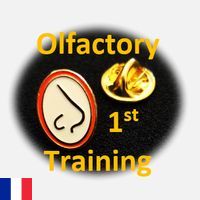
Olfactory training protocol – Anosmie.org association – France – Protocole de rééducation olfactive traduit en Anglais
Hello, I hope you are fine !
Our association is very pleased to provide you with the English translation of the olfactory training published in 2019 in collaboration with Hirac Gurden Neurobiologist and Neuroscience research Director at the CNRS (National Centre for Scientific Research). This translation in English will allow an even larger audience to benefit from the training freely.
This protocol is based on the numerous publications and international work of Professor Thomas Hummel’s research team in Dresden (Germany). You can find these publications at the following address: https://www.researchgate.net/profile/Thomas_Hummel.
Hirac Gurden and Jean-Michel Maillard have modified Professor Hummel’s protocol, with his approval, to adapt it to a general population.
THE OBJECTIVE OF THIS PROTOCOL
The protocol aims at providing sensory progress mainly to those who have lost their olfactory capacity or have had a decrease in their ability to smell.
It also intends to reconcile hyposmics (partial loss of olfaction) and ansomics (total loss of olfaction) with their decreased or lost sense of smell.
It must be specified that the protocol does not guarantee olfactory gain. However, published results in international scientific journals showed that about one third (12 weeks of training) or half (24 weeks of training) of hyposmics presented improved olfactory sensitivity after this training.
Many noted an impact on their feelings during mealtimes and the redevelopment of their sense of taste. They also say that they feel much better and that there is an improvement in their quality of life.
WHO IS THIS PROTOCOL FOR?
This protocol is mainly for hyposmics and for anosmics, whatever the origin of their dysosmic disorder. The case of congenital anosmia must be set aside, due to the lack of olfactory receptors expression and to the reduction of the volume of the olfactory bulbs. (For those people, there is however the possibility of stimulating the trigeminal nerve terminals in the nose. This subject will appear in a second specific protocol that will be published later on.)
This protocol is also for normosmics (people who have a “normal” sense of smell) to improve their olfactory sensitivity. Good olfactory sensitivity is not inborn and must be developed at an early age. Therefore, we place children in the front line of this apprenticeship, for their smell is a precious sense that must be stimulated. Normosmic parents could equally benefit from this olfactory stimulation with their children.
Early changes can be detected by the person him/herself. Nevertheless, patients who wish to follow this protocol are advised to take an olfactory sensitivity test at an E.N.T. (Ear, Nose & Throat) hospital service, before and after the training in order to verify any change in their sensitivity.
The association decided to give this training to EVERYBODY for free, no need to be a donator or to join, we are a nonprofit organization. Yet, you are free to support the association so that it can go on with its work, actions and breakthroughs for our handicap.

⇒ Download this olfactory training protocol V1.1E
Many thanks to…
Linda, my wife
Hirac GURDEN, Director of research in neuroscience at CNRS – Paris
Robert CHHUOR, E.N.T. Surgeon. Atlantic group – Nantes
Translated from French by Julian GREENWOLD, congenital anosmic – Paris
Claire FANCHINI, traumatic anosmic – Angers
and Linda MAILLARD, normosmic – Durcet
“Our life is worth what it has cost us”. Mauriac
PS : Pour les Français qui liront cet article, il s’agit de notre protocole de rééducation traduit en anglais, les demandes sont très nombreuses.
Presidant of the association
#day 1822
En savoir plus sur Association Anosmie.org
Subscribe to get the latest posts sent to your email.

Dear,
Yes you can do it after meal. Me, I did it just before going to bed.
One or two hours after meal for example.
Best regards from France,
Hi I would like to thank you for providing an English version of this training protocol which I just discovered today. I have actually started this about a week ago using the French version.
I would just like to bring to your attention (or shall I say verify which one is correct) regarding the protocol sequence.
In English it says: the exercises to be done “In the evening before or after dinner or before going to bed
While In French it says: “Le soir avant le diner, avant même l’apéritif”
Can this really be done after dinner?
Thank you for your confirmation.